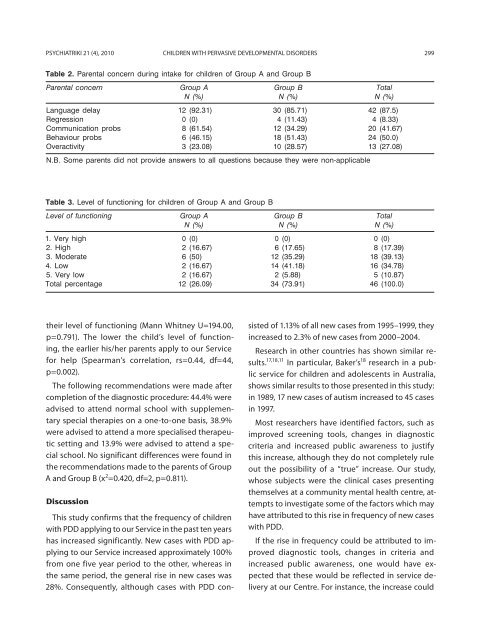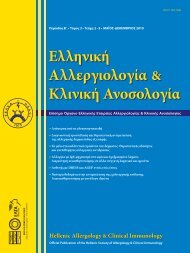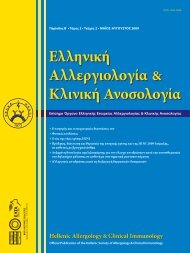ÏÏ ÏιαÏÏικη - ÎÎΤΠÎαÏÏικÎÏ ÎκδÏÏειÏ
ÏÏ ÏιαÏÏικη - ÎÎΤΠÎαÏÏικÎÏ ÎκδÏÏειÏ
ÏÏ ÏιαÏÏικη - ÎÎΤΠÎαÏÏικÎÏ ÎκδÏÏειÏ
- No tags were found...
You also want an ePaper? Increase the reach of your titles
YUMPU automatically turns print PDFs into web optimized ePapers that Google loves.
PSYCHIATRIKI 21 (4), 2010 CHILDREN WITH PERVASIVE DEVELOPMENTAL DISORDERS 299Table 2. Parental concern during intake for children of Group A and Group BParental concern Group A Group B TotalN (%) N (%) N (%)Language delay 12 (92.31) 30 (85.71) 42 (87.5)Regression 0 (0) 4 (11.43) 4 (8.33)Communication probs 8 (61.54) 12 (34.29) 20 (41.67)Behaviour probs 6 (46.15) 18 (51.43) 24 (50.0)Overactivity 3 (23.08) 10 (28.57) 13 (27.08)N.B. Some parents did not provide answers to all questions because they were non-applicableTable 3. Level of functioning for children of Group A and Group BLevel of functioning Group A Group B TotalN (%) N (%) N (%)1. Very high 0 (0) 0 (0) 0 (0)2. High 2 (16.67) 6 (17.65) 8 (17.39)3. Moderate 6 (50) 12 (35.29) 18 (39.13)4. Low 2 (16.67) 14 (41.18) 16 (34.78)5. Very low 2 (16.67) 2 (5.88) 5 (10.87)Total percentage 12 (26.09) 34 (73.91) 46 (100.0)their level of functioning (Mann Whitney U=194.00,p=0.791). The lower the child’s level of functioning,the earlier his/her parents apply to our Servicefor help (Spearman’s correlation, rs=0.44, df=44,p=0.002).The following recommendations were made aftercompletion of the diagnostic procedure: 44.4% wereadvised to attend normal school with supplementaryspecial therapies on a one-to-one basis, 38.9%were advised to attend a more specialised therapeuticsetting and 13.9% were advised to attend a specialschool. No significant differences were found inthe recommendations made to the parents of GroupA and Group B (x 2 =0.420, df=2, p=0.811).DiscussionThis study confirms that the frequency of childrenwith PDD applying to our Service in the past ten yearshas increased significantly. New cases with PDD applyingto our Service increased approximately 100%from one five year period to the other, whereas inthe same period, the general rise in new cases was28%. Consequently, although cases with PDD consistedof 1.13% of all new cases from 1995–1999, theyincreased to 2.3% of new cases from 2000–2004.Research in other countries has shown similar results.17,18,11 In particular, Baker’s 18 research in a publicservice for children and adolescents in Australia,shows similar results to those presented in this study:in 1989, 17 new cases of autism increased to 45 casesin 1997.Most researchers have identified factors, such asimproved screening tools, changes in diagnosticcriteria and increased public awareness to justifythis increase, although they do not completely ruleout the possibility of a “true” increase. Our study,whose subjects were the clinical cases presentingthemselves at a community mental health centre, attemptsto investigate some of the factors which mayhave attributed to this rise in frequency of new caseswith PDD.If the rise in frequency could be attributed to improveddiagnostic tools, changes in criteria andincreased public awareness, one would have expectedthat these would be reflected in service deliveryat our Centre. For instance, the increase could













